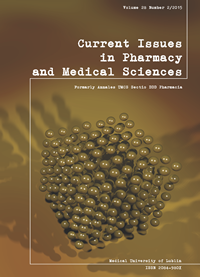Effectiveness of psychopharmacology in Anorexia Nervosa treatment
DOI:
https://doi.org/10.1515/cipms-2015-0046Keywords:
anorexia nervosa, treatment, psychopharmacologyAbstract
The eating disorder that generates the highest death rate is that of anorexia nervosa, and current treatment is a combination of equalization of somatic state and patient education. Moreover, psychical symptoms occurring in the course of anorexia nervosa are thought to have a crucial influence on the course of the disease. Hence, in medical literature, the effectiveness of psychotherapeutic interventions is also widely described.
Still, the implementation of appropriate psychopharmacology is now considered an additional method of treatment, rather than a therapy of choice. Yet, in spite of many years of research, there are no absolute recommendations given, nor are instructions within the scope of psychopharmacological treatment proffered, although the selection of psychopharmacological items must respect both the patient’s psychic and somatic states. In recent years, the popularity of psychopharmacological treatment has increased; therefore, we feel that it is justified to present the latest scientific information in this respect.
References
1. Bissada H. et al.: Olanzapine in the treatment of low body weight and obsessive thinking in women with anorexia nervosa: a randomized, double-blind, placebo-controlled trial. Am J Psychiatry, 165, 10,2008.
2. Court A. et al.: Investigating the effectiveness, safety and tolerability of quetiapine in the treatment of anorexia nervosa in young people: a pilot study. J Psychiatr Res., 44, 15, 2010.
3. Hagman J. et al.: A double-blind, placebo-controlled study of risperidone for the treatment of adolescents and young adults with anorexia nervosa: a pilot study. J Am Acad Child Adolesc Psychiatry, 50, 9, 2011.
4. Kaye W.H. et al.: Double-blind placebo-controlled administration of fluoxetine in restricting- and restricting-purging-type anorexia nervosa. Biol Psychiatry, 2001 49, 7, 2001.
5. Kouidrat Y. et al.: Eating disorders in schizophrenia: implications for research and management. Schizophr Res Treatment, 2014.
6. Kracke E.J., Tosh A.K.: Treatment of anorexia nervosa with long-term risperidone in an outpatient setting: case study. Springerplus, 2, 3, 2014.
7. Kucharska-Pietura K. et al.: The recognition of emotion in the faces and voice of anorexia nervosa. Int J Eat Disord., 35, 1, 2004.
8. Lacey J.H., Crisp A.H.: Hunger, food intake and weight: the impact of clomipramine on a refeeding anorexia nervosa population. Postgrad Med J., 56, 1, 1980.
9. Madden S. et al.: Burden of eating disorders in 5-13-year-old children in Australia. Med J Aust., 20, 8, 2009.
10. Okita K. et al.: Tandospirone, a 5-HT1A partial agonist is effective in treating anorexia nervosa: a case series. Annals of General Psychiatry, 12, 7, 2013.
11. Pinhas L. et al.: Incidence and age-specific presentation of restrictive eating disorders in children: a Canadian Paediatric Surveillance Program study. Arch Pediatr Adolesc Med., 165, 10, 2011.
12. Powers P.S., Klabunde M., Kaye W.: Double-blind placebo-controlled trial of quetiapine in anorexia nervosa. Eur Eat Disord Rev., 20, 4, 2012.
13. Smink F.R., van Hoeken D., Hoek H.W.: Epidemiology of eating disorders: incidence, prevalence and mortality rates. Curr Psychiatry Rep., 14, 4, 2012.
14. Strobel M. et al.: Paroxetine versus clomipramine in female adolescents suffering from anorexia nervosa and depressive episode – a retrospective study on tolerability, reasons for discontinuing the antidepressive treatment and different outcome measurements. Z Kinder Jugendpsychiatr Psychother., 32, 4, 2004.
15. Umehara H., Iga J., Ohmori T.: Successful Treatment of Anorexia Nervosa in a 10-year-old Boy with Risperidone Long-acting Injection. Clin Psychopharmacol Neurosci., 12, 1, 2014.
16. Walsh B.T. et al.: Fluoxetine after weight restoration in anorexia nervosa: a randomized controlled trial. JAMA, 14, 22, 2006.
Downloads
Published
Issue
Section
License
Copyright (c) 2015 Authors

This work is licensed under a Creative Commons Attribution-NonCommercial-NoDerivatives 3.0 Unported License.


